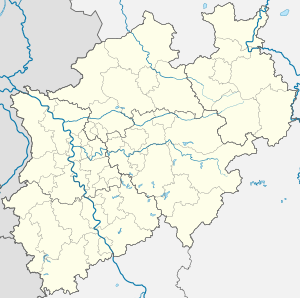Kevelaer
Kevelaer is a town in the district of Kleve, in North Rhine-Westphalia in Germany. It is the largest Catholic pilgrimage location within north-western Europe. More than 1 million pilgrims, mostly from Germany and the Netherlands, visit Kevelaer every year to honour the Virgin Mary.[2] The population in 2015 was 28,311.
Kevelaer | |
|---|---|
 Basilica of the Virgin Mary | |
 Coat of arms | |
Location of Kevelaer within Kleve district  | |
 Kevelaer  Kevelaer | |
| Coordinates: 51°35′0″N 06°15′0″E | |
| Country | Germany |
| State | North Rhine-Westphalia |
| Admin. region | Düsseldorf |
| District | Kleve |
| Subdivisions | 5 |
| Government | |
| • Mayor | Dominik Pichler (SPD) |
| Area | |
| • Total | 100.6 km2 (38.8 sq mi) |
| Elevation | 20 m (70 ft) |
| Population (2018-12-31)[1] | |
| • Total | 28,021 |
| • Density | 280/km2 (720/sq mi) |
| Time zone | CET/CEST (UTC+1/+2) |
| Postal codes | 47623, 47624, 47625, 47626, 47627 |
| Dialling codes | 0 28 32 |
| Vehicle registration | KLE, GEL |
| Website | www.kevelaer.de |
History
![]()
![]()
![]()
![]()
![]()
![]()
![]()
![]()
![]()
![]()
![]()
![]()
![]()
![]()
![]()
![]()
Kevelaer is a center of veneration and pilgrimage to Our Lady, Comforter of the Afflicted (also known as Our Lady of Consolation. According to tradition, a merchant named Hendrik Busman, in the days before Christmas, 1641, three times heard a voice saying "Here thou shalt build me a chapel". He began to set money aside but feared his wife, Mechel, wouldn't approve. She, however, had a vision, around Pentecost, in which she saw a little chapel containing a print of Our Lady of Consolation, all bathed in light. The story was confirmed by two passing soldiers, who saw the house light up at night. Days before, two soldiers had tried to sell her two copperplate engravings with the same image on it, but she found it too expensive. Hendrik began building the chapel while Mechel tried to obtain the print. The chapel was consecrated and on 1 June 1642, the Sunday after Assumption of Mary, the print was displayed in it, and the chapel became such a popular destination for pilgrims that a church was built for them between 1643 and 1645. The little chapel was replaced in 1654 with a larger one, the Gnadenkapelle, which still houses the print.[3]
It is one of the best visited Catholic pilgrimage locations in north-western Europe. The Gnadenkapelle (Chapel of Grace) has drawn pilgrims to the Lower Rhine Region from all over the world for more than 360 years.[2] Pope John Paul II visited in 1987.[4]
Twin town
Gallery
 Basilica
Basilica Kevelaerer picture of Grace
Kevelaerer picture of Grace Chapel
Chapel
Notable people
- Franz-Peter Tebartz-van Elst (born 1959), German prelate of the Catholic Church and theologian.
- Markus Meurer (born 1959), German outsider artist.
References
- "Bevölkerung der Gemeinden Nordrhein-Westfalens am 31. Dezember 2018" (in German). Landesbetrieb Information und Technik NRW. Retrieved 10 July 2019.
- City of Kevelaer
- Verspaandonk, J. A. J. M. (1975). Het hemels prentenboek: Devotie- en bidprentjes vanaf de 17e eeuw tot het begin van de 20e eeuw. Hilversum: Gooi en Sticht. p. 12.
- "City of Kevelaer - Wallfahrt". www.kevelaer.de.
External links
- Official website

- “Build Me A Chapel On This Spot”
- "Welcome to Pilgrimage centre of Kevelaer". Wallfahrtsleitung Kevelaer. Archived from the original on 2013-09-27. Retrieved 2013-09-26.
- "The Pilgrimage Site of Kevelaer". Unverwechselbar Kevelaer. Retrieved 2013-09-26.
| Wikimedia Commons has media related to Kevelaer. |